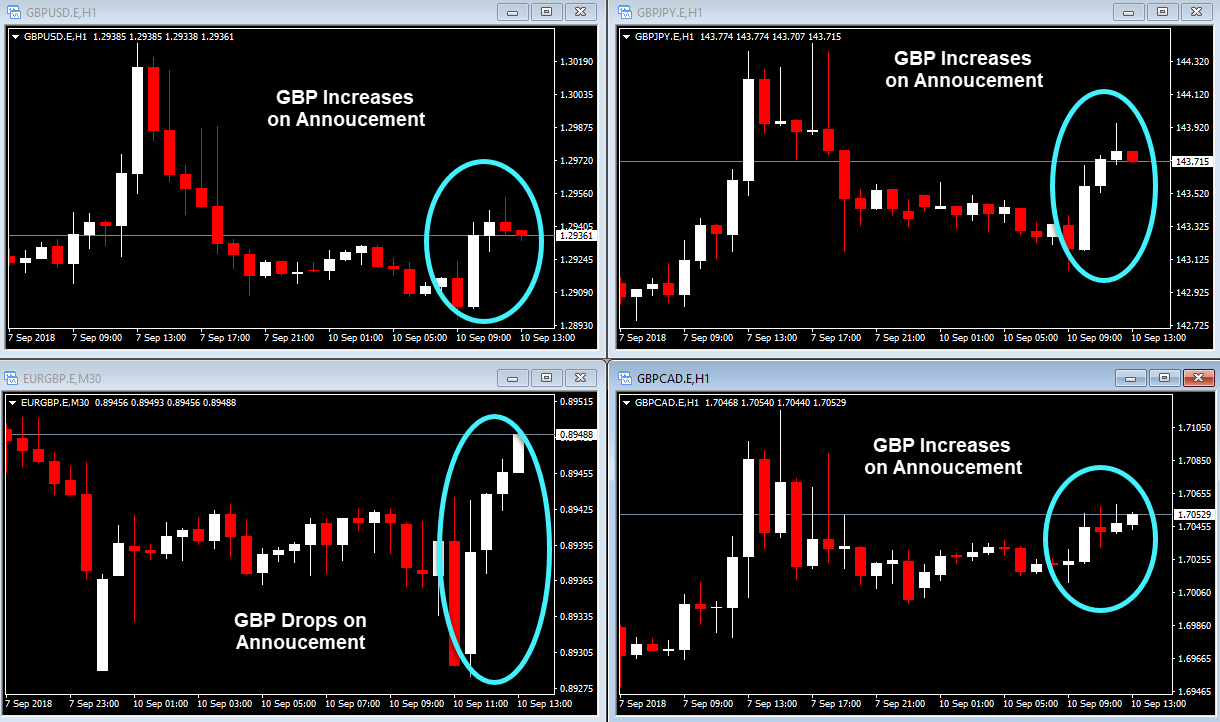EURGBP, GBPJPY, GBPUSD, GBPCAD, H1
The real GDP figure for the UK came out more positive than expected for the three months which ended in July, although this is still mainly attributed to the growth in consumption during the World Cup period. The ONS aptly makes note of this, suggesting that “When Quarter 3 (July to September) growth is calculated, the poor growths of February and March will have dropped out of the base period”. Even though it is only hinted in the above sentence what investors should take from it is that the overall growth rate of the third quarter, which includes July, would most likely be less than the 0.6% number produced today, unless growth in August and September compensates for this.
Still, growth for July was higher than expected, at 0.3% versus a projected 0.2% growth. Again, this could be part of the “World Cup Effect”, given that England played its last match on July 14. Construction increased by 0.5% in July, at a record higher level, driven by stronger than usual growth in housebuilding. Services also grew by 0.3%, driven by retail and wholesale trade, which adds more credibility to the World Cup Effect. In contrast, manufacturing recorded negative growth rates in July, marking the fifth consecutive rolling period with negative growth rates. Overall industrial production growth slowed to 0.1% in July against the expectated 0.2%.
Excluding the real GDP figure, the UK has faced a deterioration in manufacturing and industrial output which would have plunged the Sterling in any other day. Still, better-than-expected real GDP results saved the day. In our view, real GDP results were mainly driven by the positive developments in the Trade Balance, which came out almost GBP0.5 bln better than expected in July. This effect was likely a result of the Sterling depreciation, which aided in UK goods price competitiveness. UK exports have been increasing since the Brexit referendum and the Sterling depreciation, albeit this can be mostly attributed to trade with third countries and not with the EU. As previously elaborated, regarding the trade deficit and exchange rate relationship, this is probably why the EURGBP pair moved against the Sterling, while the Pound has gained with respect to the Deposit, Yen and the Loonie.
The lesson to be learned from the above is that data can be presented and interpreted in various ways. It is up to the trader to figure out which way is closest to the truth and, following from this, which way should be followed to place trade. As usual, remember that correct risk management strategies assist in minimising losses in case our interpretation of the data is incorrect.
Click here to access the HotForex Economic calendar.
Want to learn to trade and analyse the markets? Join our webinars and get analysis and trading ideas combined with better understanding on how markets work. Click HERE to register for FREE! The next webinar will start in:
[ujicountdown id=”Next Webinar” expire=”2018/09/11 14:00″ hide=”true” url=”” subscr=”” recurring=”” rectype=”second” repeats=””]
Dr Nektarios Michail
Market Analyst
HotForex
Disclaimer: This material is provided as a general marketing communication for information purposes only and does not constitute an independent investment research. Nothing in this communication contains, or should be considered as containing, an investment advice or an investment recommendation or a solicitation for the purpose of buying or selling of any financial instrument. All information provided is gathered from reputable sources and any information containing an indication of past performance is not a guarantee or reliable indicator of future performance. Users acknowledge that any investment in FX and CFDs products is characterized by a certain degree of uncertainty and that any investment of this nature involves a high level of risk for which the users are solely responsible and liable. We assume no liability for any loss arising from any investment made based on the information provided in this communication. This communication must not be reproduced or further distributed without our prior written permission.



















